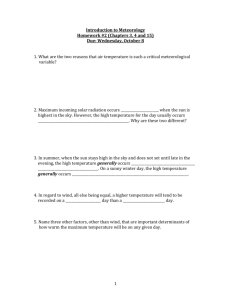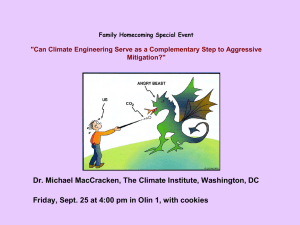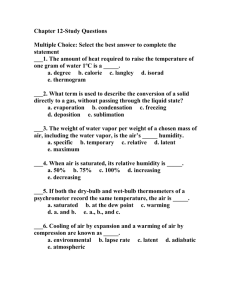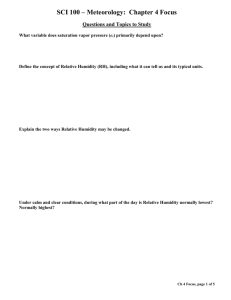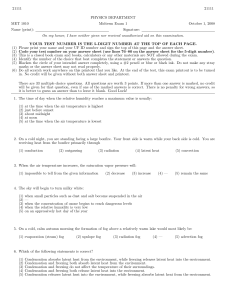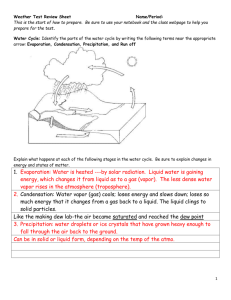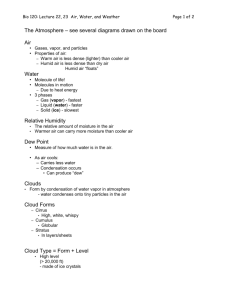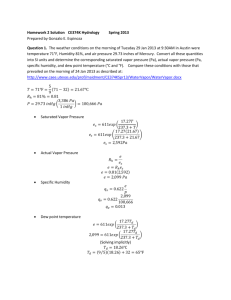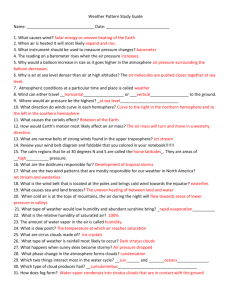Homework #2 – Answers
advertisement
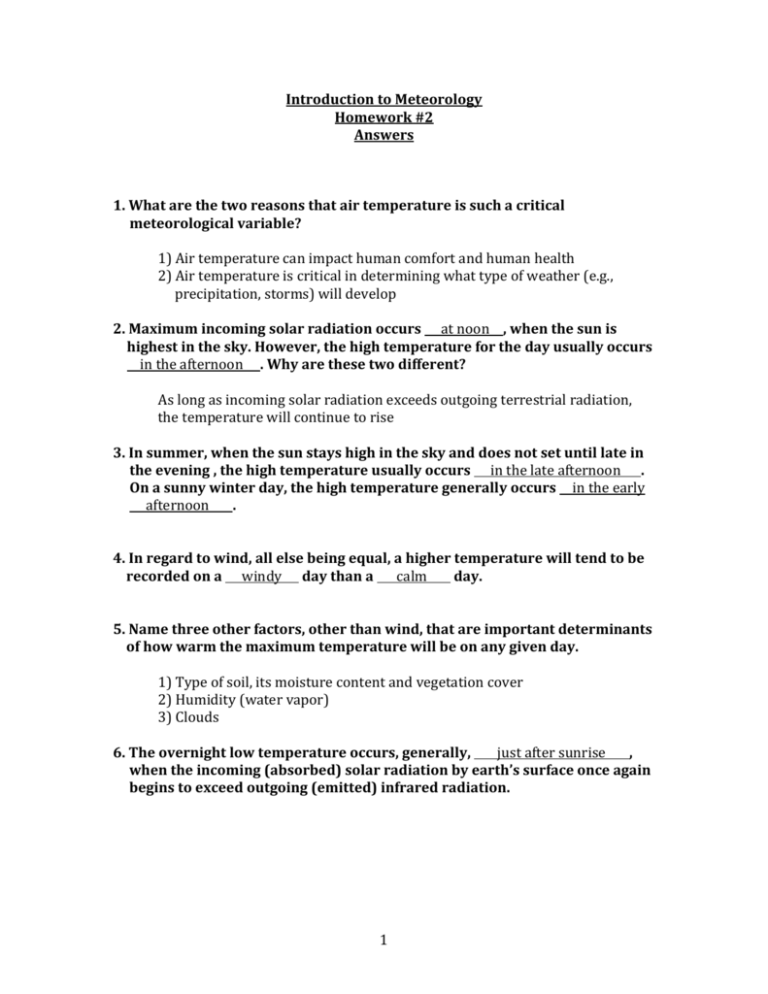
Introduction to Meteorology Homework #2 Answers 1. What are the two reasons that air temperature is such a critical meteorological variable? 1) Air temperature can impact human comfort and human health 2) Air temperature is critical in determining what type of weather (e.g., precipitation, storms) will develop 2. Maximum incoming solar radiation occurs at noon , when the sun is highest in the sky. However, the high temperature for the day usually occurs in the afternoon . Why are these two different? As long as incoming solar radiation exceeds outgoing terrestrial radiation, the temperature will continue to rise 3. In summer, when the sun stays high in the sky and does not set until late in the evening , the high temperature usually occurs in the late afternoon . On a sunny winter day, the high temperature generally occurs in the early afternoon . 4. In regard to wind, all else being equal, a higher temperature will tend to be recorded on a windy day than a calm day. 5. Name three other factors, other than wind, that are important determinants of how warm the maximum temperature will be on any given day. 1) Type of soil, its moisture content and vegetation cover 2) Humidity (water vapor) 3) Clouds 6. The overnight low temperature occurs, generally, just after sunrise , when the incoming (absorbed) solar radiation by earth’s surface once again begins to exceed outgoing (emitted) infrared radiation. 1 7. What are the four primary factors that determine how cold the overnight minimum temperature will be on any given day? 1) Length of the night 2) Cloudiness 3) Wind 4) Moisture Content of the air 8. The coldest temperatures occur on in winter . clear , calm , dry nights 9. On these types of nights (previous question) an atypical vertical temperature profile develops in which it is coldest near the ground and warmer above. What is this temperature profile called? Radiation inversion 10. The coldest air and lowest temperatures overnight are usually found in low-lying areas such as at the bottom of valleys and basins . The reason for this is that cold air is heavy (dense) and will drain downhill and settle at the lowest point. 11. What practical relevance does a radiation inversion have in regard to air pollution? It acts like lid on rising pollution, trapping it near the ground. 12. a) What type of conditions, cloudy or clear, will result in a small daily temperature range? b) Why? a) Cloudy conditions b) Cooler days and warmer nights 13. a) Which city will have a smaller daily temperature range; Atlantic City, NJ or Denver, CO? b) Why? a) Atlantic City, NJ b) Proximity to moderating effect of large body of water (Atlantic Ocean) 14. What is the urban heat island effect? Temperatures measured in urban areas are at least several degrees higher than rural areas 2 15. a) What is the main determinant of the temperature any given region will have over the course of the year (i.e. climate of a region)? b) What are three other determinants? a) Latitude b) 1. Ocean and Land Distribution (Coastal vs. Continental) 2. Ocean Currents 3. Altitude/Elevation 16. a) How is heating degree days determined? b) What purpose does calculating heating degree days serve? a) Subtract daily mean temperature from 65°F b) Utilized for estimating the consumption of heating fuel 17. Do we feel colder on a windy, cold day or on a calm, cold day (wind chill index)? Windy, cold day 18. Electrical thermometers are more sensitive and accurate than liquid-in-glass thermometers and have largely replaced them for use in weather stations. 19. In order that an air temperature reading be accurate, it must be recorded in the shade . 20. What is the major source of water vapor in the atmosphere? Evaporation from oceans (85% of atmospheric water vapor) 21. What is “vapor pressure (VP)”? A measure of the absolute amount of water vapor (molecules) in the air or the air’s water vapor content 22. a) What is “saturation vapor pressure (SVP)”? b) What atmospheric variable is the sole determinant of SVP? c) Which has a higher SVP, warm air or cold air? a) The amount of water vapor molecules (vapor pressure) that the air can “hold” before saturation occurs, or the air’s water vapor capacity b) Temperature c) Warm air 3 23. Relative humidity is a measure of how close the air is to being saturated . 24. a) What is dew point? b) Why is dew point a better measure of human discomfort than relative humidity? a) The temperature to which air would have to be cooled in order for saturation to occur (the point at which dew will form or condensation will occur) b) It takes into account both temperature and relative humidity 25. Which is lighter, moist air or dry air? Moist air 26. Dew and frost form when the temperature near the ground reaches dew point . the 27. What are the two ways that fog can form? 1) Cooling – air is cooled below its dew point 2) Evaporation – water vapor is added to the air until it becomes saturated 28. What type of fog forms on clear, calm nights in late fall or winter over land, particularly in valleys? Radiation fog 29. What type of fog is common in San Francisco, London and along the Maine Coast? Advection fog 30. What is the definition of a cloud? A visible aggregate of tiny water droplets or ice crystals suspended in the air (fog away from earth’s surface) 31. There are four groups of cloud types. Three groups are based upon the height of the clouds base above earth’s surface and the fourth group contains clouds that show vertical development . 4 32. What “thin, wispy cloud” is the most common type of high cloud? Cirrus 33. What type of clouds can create a “halo” around the sun or moon and frequently form well in advance of an advancing mid-latitude cyclone (storm system)? Cirrostratus 34. What type of low cloud is dark grey and associated with more or less continuously falling rain or snow (sometimes called a “rain” cloud)? Nimbostratus 35. What type of cloud, frequently associated with fair weather, appear as puffy, floating cotton with sharp outlines and a flat base? Cumulus 36. What type of clouds are “thunderstorm” clouds? Cumulonimbus 37. Why is the sky blue? Oxygen and nitrogen (~98% of the atmosphere’s constituents) are so small that they only scatter the shortest wavelengths (blue). Therefore, blue light is scattered to our eyes from all directions and the entire sky (atmosphere) appears blue 38. Why are sunrises and sunsets yellow, orange and red? Near sunrise or sunset, the sun’s rays must pass through an atmosphere that is 12 times thicker than when it is overhead. By the time the light from the sun reaches an observer all of the shorter wavelengths of light (blue) have been scattered out and only the longer wavelengths; yellow, orange and red remain 39. What type of optical process, which causes twinkling stars, mirages and halos is due to the fact that light changes speed in air of different density, causing it to “bend”? Refraction 5 40. Multiple colorful optical phenomena such as sun dogs and rainbows are caused by what additional optical process that results in a separation of the different colors of the light spectrum? Dispersion 6
